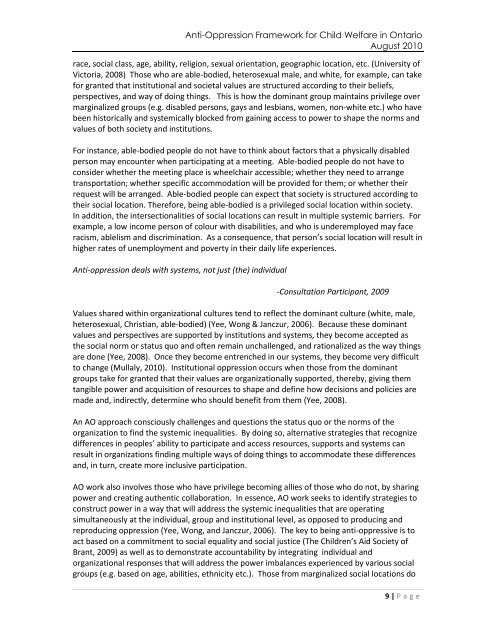An Anti-Oppression Framework for Child Welfare in Ontario
An Anti-Oppression Framework for Child Welfare in Ontario
An Anti-Oppression Framework for Child Welfare in Ontario
You also want an ePaper? Increase the reach of your titles
YUMPU automatically turns print PDFs into web optimized ePapers that Google loves.
<strong>An</strong>ti-<strong>Oppression</strong> <strong>Framework</strong> <strong>for</strong> <strong>Child</strong> <strong>Welfare</strong> <strong>in</strong> <strong>Ontario</strong>August 2010race, social class, age, ability, religion, sexual orientation, geographic location, etc. (University ofVictoria, 2008) Those who are able-bodied, heterosexual male, and white, <strong>for</strong> example, can take<strong>for</strong> granted that <strong>in</strong>stitutional and societal values are structured accord<strong>in</strong>g to their beliefs,perspectives, and way of do<strong>in</strong>g th<strong>in</strong>gs. This is how the dom<strong>in</strong>ant group ma<strong>in</strong>ta<strong>in</strong>s privilege overmarg<strong>in</strong>alized groups (e.g. disabled persons, gays and lesbians, women, non-white etc.) who havebeen historically and systemically blocked from ga<strong>in</strong><strong>in</strong>g access to power to shape the norms andvalues of both society and <strong>in</strong>stitutions.For <strong>in</strong>stance, able-bodied people do not have to th<strong>in</strong>k about factors that a physically disabledperson may encounter when participat<strong>in</strong>g at a meet<strong>in</strong>g. Able-bodied people do not have toconsider whether the meet<strong>in</strong>g place is wheelchair accessible; whether they need to arrangetransportation; whether specific accommodation will be provided <strong>for</strong> them; or whether theirrequest will be arranged. Able-bodied people can expect that society is structured accord<strong>in</strong>g totheir social location. There<strong>for</strong>e, be<strong>in</strong>g able-bodied is a privileged social location with<strong>in</strong> society.In addition, the <strong>in</strong>tersectionalities of social locations can result <strong>in</strong> multiple systemic barriers. Forexample, a low <strong>in</strong>come person of colour with disabilities, and who is underemployed may faceracism, ablelism and discrim<strong>in</strong>ation. As a consequence, that person’s social location will result <strong>in</strong>higher rates of unemployment and poverty <strong>in</strong> their daily life experiences.<strong>An</strong>ti-oppression deals with systems, not just (the) <strong>in</strong>dividual-Consultation Participant, 2009Values shared with<strong>in</strong> organizational cultures tend to reflect the dom<strong>in</strong>ant culture (white, male,heterosexual, Christian, able-bodied) (Yee, Wong & Janczur, 2006). Because these dom<strong>in</strong>antvalues and perspectives are supported by <strong>in</strong>stitutions and systems, they become accepted asthe social norm or status quo and often rema<strong>in</strong> unchallenged, and rationalized as the way th<strong>in</strong>gsare done (Yee, 2008). Once they become entrenched <strong>in</strong> our systems, they become very difficultto change (Mullaly, 2010). Institutional oppression occurs when those from the dom<strong>in</strong>antgroups take <strong>for</strong> granted that their values are organizationally supported, thereby, giv<strong>in</strong>g themtangible power and acquisition of resources to shape and def<strong>in</strong>e how decisions and policies aremade and, <strong>in</strong>directly, determ<strong>in</strong>e who should benefit from them (Yee, 2008).<strong>An</strong> AO approach consciously challenges and questions the status quo or the norms of theorganization to f<strong>in</strong>d the systemic <strong>in</strong>equalities. By do<strong>in</strong>g so, alternative strategies that recognizedifferences <strong>in</strong> peoples’ ability to participate and access resources, supports and systems canresult <strong>in</strong> organizations f<strong>in</strong>d<strong>in</strong>g multiple ways of do<strong>in</strong>g th<strong>in</strong>gs to accommodate these differencesand, <strong>in</strong> turn, create more <strong>in</strong>clusive participation.AO work also <strong>in</strong>volves those who have privilege becom<strong>in</strong>g allies of those who do not, by shar<strong>in</strong>gpower and creat<strong>in</strong>g authentic collaboration. In essence, AO work seeks to identify strategies toconstruct power <strong>in</strong> a way that will address the systemic <strong>in</strong>equalities that are operat<strong>in</strong>gsimultaneously at the <strong>in</strong>dividual, group and <strong>in</strong>stitutional level, as opposed to produc<strong>in</strong>g andreproduc<strong>in</strong>g oppression (Yee, Wong, and Janczur, 2006). The key to be<strong>in</strong>g anti-oppressive is toact based on a commitment to social equality and social justice (The <strong>Child</strong>ren’s Aid Society ofBrant, 2009) as well as to demonstrate accountability by <strong>in</strong>tegrat<strong>in</strong>g <strong>in</strong>dividual andorganizational responses that will address the power imbalances experienced by various socialgroups (e.g. based on age, abilities, ethnicity etc.). Those from marg<strong>in</strong>alized social locations do9 | P a g e
















